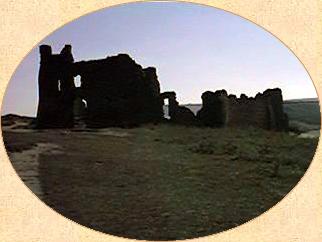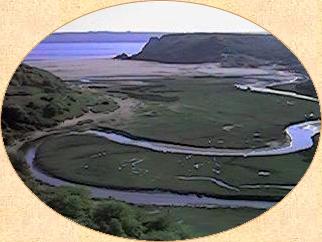
Lords
of Gower

If William de Braose neglected
his duties as a landlord, it was probably because his king demanded
so much from him in war.
Edward
I called out the feudal host in 1277 and began a determined series
of campaigns to conquer Wales. His Welsh wars continued for twenty
five years and brought an end to Welsh independence. William
gained his early military education as a squire to Reginald de
Grey, lord of Ruthin, who fought in Wales. William's father took
men from Bramber and Gower to fight Llewelyn, the last great
prince of Wales, who was killed in 1282. The siege of Emlyn (near
Cardigan) in January 1288 illustrates what an enormous commitment
the lords of Gower made to the Welsh wars.
William was still his father's
heir when he fought to subdue Rhys ap Maredudd that winter. He
had seven mounted knights and sixty three foot soldiers in his
personal following. He raised another three heavy and eighteen
light horse, two mounted and nineteen foot crossbowmen, and 400
foot. The army used hundreds of woodmen from the Forest of Dean
to hack a path through the wooded mountains.
William also had an enormous
siege engine. It was hauled across the difficult winter terrain
on four carts, pulled by forty oxen which were later increased
to sixty. He employed men to pick up 480 rocks on the beach below
Cardigan and take them by sea and up the river Teify to Llechryd.
From there the stones were carried by 120 pack horses.

The siege engine needed
blacksmiths, mechanics, twenty four woodcutters to make a bridge
for the assault, two master workmen and large quantities of pig
fat to grease it. It was escorted by twenty horse and 463 foot
soldiers, who were also William de Braose's men.
The siege began on New
Year's Day and was over by January 20. Detailed administrative
records of the siege still exist. (24.1)
They show that not one man was lost by the English force. Presumably
the great siege engine and its 480 rocks wore down the Welsh
defenders of Emlyn castle and persuaded them to surrender peaceably.
As the English crown subdued
Wales, the autonomy of the marcher lords was inevitably the next
royal target. Under Edward II William de Braose was the unwitting
cause of a bloody showdown, after which the marcher lords were
never to recover their former glory.

The
ruins of Pennard castle are a haunting reminder of the de Braose
lords of Gower. The castle is reached by walking up a steep path
opposite the Parc le Breos, then along the cliff top beside an
extensive golf course. The views are spectacular. The foundations
of a small church provide a most unusual obstacle for the golfers.
Pennard is thought to have
been a hunting lodge. It probably offered William de Braose and
his father some rest and recreation during the Welsh wars, although
it's lands were devastated by Atlantic storms between 1315 and
1317.
back
to text

 If William de Braose neglected his duties as a landlord, it was probably because his king demanded so much from him in war. Edward I called out the feudal host in 1277 and began a determined series of campaigns to conquer Wales. His Welsh wars continued for twenty five years and brought an end to Welsh independence. William gained his early military education as a squire to Reginald de Grey, lord of Ruthin, who fought in Wales. William's father took men from Bramber and Gower to fight Llewelyn, the last great prince of Wales, who was killed in 1282. The siege of Emlyn (near Cardigan) in January 1288 illustrates what an enormous commitment the lords of Gower made to the Welsh wars. William was still his father's heir when he fought to subdue Rhys ap Maredudd that winter. He had seven mounted knights and sixty three foot soldiers in his personal following. He raised another three heavy and eighteen light horse, two mounted and nineteen foot crossbowmen, and 400 foot. The army used hundreds of woodmen from the Forest of Dean to hack a path through the wooded mountains. William also had an enormous
siege engine. It was hauled across the difficult winter terrain
on four carts, pulled by forty oxen which were later increased
to sixty. He employed men to pick up 480 rocks on the beach below
Cardigan and take them by sea and up the river Teify to Llechryd.
From there the stones were carried by 120 pack horses.  The siege engine needed blacksmiths, mechanics, twenty four woodcutters to make a bridge for the assault, two master workmen and large quantities of pig fat to grease it. It was escorted by twenty horse and 463 foot soldiers, who were also William de Braose's men. The siege began on New Year's Day and was over by January 20. Detailed administrative records of the siege still exist. (24.1) They show that not one man was lost by the English force. Presumably the great siege engine and its 480 rocks wore down the Welsh defenders of Emlyn castle and persuaded them to surrender peaceably. As the English crown subdued Wales, the autonomy of the marcher lords was inevitably the next royal target. Under Edward II William de Braose was the unwitting cause of a bloody showdown, after which the marcher lords were never to recover their former glory.
|
|||